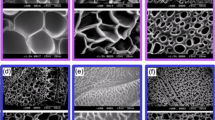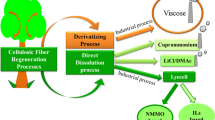Abstract
The scientific principles of direct dissolution of cellulose in the NMMO—water system demonstrate the major possibility of obtaining concentrated spinning solutions and spinning hydrated cellulose fibres from them. The specific features of the properties of NMMO (high boiling point and insufficient thermal stability) that dissolves the NMMO—water system (narrow concentration range, optimum for dissolution of cellulose) makes it necessary to recycle the washing water by evaporating it, which causes high power consumption for this process. It is expedient to examine the possibilities of membrane technologies, including electrodialysis, for solving problems of recycling the solvent and cutting power consumption. However, this path only allows partially concentrating used washing water, since there is the danger of crystallization of NMMO di-and monohydrate. Spinning through an air gap from highly viscous solutions with long relaxation times at high spinneret draw ratios results in highly oriented fibres with high tensile rigidity (high deformation modulus). Fabrication of fibres whose properties correspond to ordinary viscose fibres will perhaps require “going away” from highly viscous solutions to a lower concentration and spinning by the ordinary wet method, but the volume of solvent used increases significantly, recycling it is more difficult, and power consumption increases. For the same reason of high orientation, the fibres exhibit important fibrillation when wet, and a “peach skin” effect is formed in the finished textiles. To reduce fibrillation, special treatments of the fabrics must be used, biofinishing, for example. During use of the articles, fibrillation can reappear, in laundering, for example. The technology for fabricating fibres of the Lyocell type requires solving many problems. Developing research on selecting alternative solvents and dissolving systems for direct dissolution of cellulose to obtain concentrated spinning solutions is simultaneously useful.
Similar content being viewed by others
References
Z. A. Rogovin and N. N. Shorygina, Chemistry of Cellulose and Its Satellites [in Russian], Goskhimizdat, Moscow (1953).
Z. A. Rogovin, Cellulose Chemistry [in Russian], Khimiya, Moscow (1972).
G. Jame, in: Cellulose and Cellulose Derivatives, N. M. Bikales and L. Segal (eds.), Wiley-Interscience, New York (1971).
S. P. Papkov and V. G. Kulichikhin, Khim. Volokna, No. 2, 29 (1980).
L. K. Golova, V. G. Kulichikhin, and S. P. Papkov, Vysokomolek. Soedin., 28A, No. 9, 1795–1809 (1986).
G. A. Petropavlovskii, A. M. Bochek, and V. M. Shek, Khim. Drevesiny, No. 2, 3–21 (1987).
S. P. Papkov and I. P. Baksheev (eds.), Physicochemical Principles of Production of Hydrated Cellulose Fibres by Nontraditional Methods [in Russian], VNIIVproekt, Mytishchi (1989).
D. D. Grinshpan, Nonaqueous Solvents of Cellulose [in Russian], Izd. Unversitetskoe, Minsk (1991).
N. P. Novoselov, E. Tager, and E. S. Sashina, Vestn. Sankt-Peterburgsk. Un-ta Tekhnol. Dizaina, No. 1, 204–215 (1997).
N. P. Novoselov and E. S. Sashina, Vestn. Sankt-Peterburgsk. Un-ta Tekhnol. Dizaina, No. 5, 132–142 (2001).
Mell. Intern., 8, 96–97 (May, 2002).
Lenzinger Ber, No. 76, 131 (1997).
V. A. Platonov, Yu. Ya. Belousov, et al., Khim. Volokna, No. 1, 27–28 (1983).
A. N. Sokira and M. M. Iovleva, Khim. Volokna, No. 5, 26–27 (1985).
A. Chanzy, S. Nawrol, et al., J. Polym. Sci. Polym. Phys. Ed, 29, No. 10, 1909–1924 (1982).
H. A. Coulsay and S. B. Smith, Titk Symposium, Separate reprint, Rudolstadt (1995), pp. 1–32.
W. Albrecht, M. Reintjes, and B. Wulfhorst, Che. Fibers Intern., 47, No. 4, 298–304 (1997).
Lenzinger Ber, No. 74, 106 (1974).
Lenzinger Ber, No. 75, 117 (1996).
“First International Lyocell Symposium 1997. “Experience Lyocell”, Lenzinger Ber, No. 77, 64 (1997).
“The “Evergreen.” Cellulosic fibers presented at different conferences in 1997,” Lenzinger Ber, No. 78, 72 (1998).
C. Woodings (ed.), Regenerated Cellulose Fibers, Woodhead Publ., Cambridge (2000).
Special Issue “Experience Lyocell II,” Lenzinger Ber, No. 80, 118 (2001).
F. Meister, D. Vorbach, et al., Chem. Fibers Int., 48, No. 1, 32–35 (1998).
C. Michels and S. Kosan, Chem. Fiber Int., 50, No. 6, 556–561 (2000).
Ch. Rohrer, P. Retzl, and H. Firgo, Chem Fibers Int. Man-Made Fiber Year Book (2001), pp. 26–28.
K. E. Perepelkin, Khim. Volokna, No. 5, 3–17; No. 6, 3–14 (2000).
R. Bauer, H. Burger, and E. Taeger, Chem. Fibers Intern., 50, No. 4, 365–369 (2000).
K. E. Perepelkin, Vestn. Sankt-Peterburgsk. Un-ta Tekhnol. Dizaina, No. 9, 47–73 (2003).
P. Kryuger, Khim. Volokna, No. 1, 31–34 (1996).
Kh. Byurger, P. Maron, et al., Khim. Volokna, No. 1, 35–39 (1996).
A. Diener and G. Raouzeous, Chem. Fibers Intern., 49, No. 2, 40–42 (1999).
L. K. Golova, Khim. Volokna, No. 1, 13–1 (1996).
L. K. Golova, Ros. Khim. Zk, 46, No. 1, 49–57 (2002).
T. Hotberg and S. Thumm, Mell. Intern., No. 3, 200–204; No. 1, 83–85 (1999).
M. Nicolai, A. Nechwatal, and K.-P. Mieck, Text. Res. J., 66, No. 9, 575–580 (1996).
T. Eynon, “Fibrillation-free Lyocell fibers. An introduction to Tencell A 100,” J. Text. Monthly, 70–75 (December 1998).
Ch. Rohrer and H. Firgo, Chem. Fibers Intern., 50, No. 6, 552–555 (2000).
Author information
Authors and Affiliations
Additional information
__________
Translated from Khimicheskie Volokna, No. 2, pp. 58–64, March–April, 2007.
Rights and permissions
About this article
Cite this article
Perepelkin, K.E. Lyocell fibres based on direct dissolution of cellulose in N-methylmorpholine N-oxide: Development and prospects. Fibre Chem 39, 163–172 (2007). https://doi.org/10.1007/s10692-007-0032-9
Issue Date:
DOI: https://doi.org/10.1007/s10692-007-0032-9




